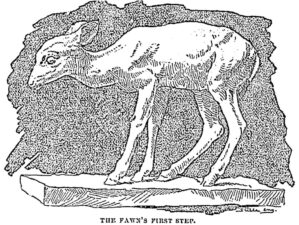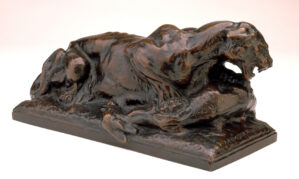and
The Fawn’s First Step; Young Fawn; First Step; Mule Deer
Banner Image: Alexander Phimister Proctor
Fawn (first model), 1914
Bronze, 6 3/4 in. (height). R.W. Norton Art Gallery, Shreveport, Louisiana
From the first time Proctor’s initial version of the Fawn received critical acclaim in the newspapers, the sculpture was paired with another work. That was in January 1893 in Chicago. Proctor had just cast in bronze the earliest variation of the Panther. A reporter from the Chicago Inter Ocean saw the two works and remarked: “The panther recently completed in bronze is an excellent example of the forceful power of his creations, and the shivering fawn overtaken by a storm shows the keen and sensitive perceptions of the sculptor.”[1]
This comment provides not only a review of the two works but also an assessment of the artist himself. The reviewer grouped the two sculptures together, and together they have a broader meaning. As a pair they reflected the complex character of the artist and made subtle reference to his biography as it had developed to this point. Revealed in his panther was Proctor’s prowess as a wilderness hunter and, in the newborn deer, his own emergence in a competitive world as an artist of note. Proctor explored the hunter theme again in his early work when he produced his lumbering Polar Bear, which, like the Panther, was first cast in 1893. At the same time, he could not forget his inherent empathy for the prey as well as the predator. By the end of 1893, he had apparently conceived at least two other variations of the baby deer.

Plate 1.1 — Alexander Phimister Proctor
Fawn, 1893
Wood engraving. Illustration in (Denver), Rocky Mountain News (October 15, 1893), 30. Buffalo Bill Center of the West, Cody, Wyoming
The first instance of the Fawn appearing in print came in mid-October 1893 when Proctor’s first model was illustrated as a plaster [Plate 1.1] in an extended article on the artist in Denver’s Rocky Mountain News.[2] The writer praised Proctor’s “knowledge of animals acquired by close study” in the Colorado backcountry. He also mentioned the fact that Proctor had been married only a few weeks before, so that this first model of the Fawn [Plate 1.2] may have provided a metaphor for familial expectations.
The Rocky Mountain News writer went on to comment about “one of the artist’s most recent efforts,” called “The Orphans,” a model projected to be cast in bronze in Paris, where the newlyweds were soon to travel. It is unknown what The Orphans looked like, as it was never cast, though it is presumed to have portrayed twin fawns. But the group was described as “so tender, graceful, touching and beautiful that those of his friends who have been permitted to see them are unmeasured in praise.”[3] Here, then, is another pairing for the infant deer.

Plate 1.2 — Alexander Phimister Proctor
Fawn (first model), ca. 1899
Bronze, 7 1/4 in. (height), Buffalo Bill Center of the West, Cody, Wyoming. Gift of A. Phimister Proctor Museum and special thanks to Sandy and Sally Church. 4.08.8
Although it is not known whether the second model of the Fawn [Plate 1.3] was one of the orphans, it certainly shared all the characteristics of the orphan model—grace, tenderness, and beauty. Possibly, then, the second model, which bears the date of 1893 stamped boldly in its base, was one of the pair. In any event, by autumn of 1893 in Paris, Proctor had at least two versions of the Fawn in his studio.

Plate 1.3 — Alexander Phimister Proctor
Mule Deer (Fawn) (second model), ca. 1898
Bronze, 6 3/4 in. (height). Amherst Library, New York, New York. Gift of George D. Pratt / Bridgeman Images
Because of his busy schedule as a student in Paris and his two big commissions with Augustus Saint-Gaudens, Proctor entered few public exhibitions between 1894 and 1899.[4] In 1900, though, at the Paris Exposition, Proctor reversed the pattern. He submitted eight small sculptures for the American display, including one he titled Young Fawn. The group of eight won him a gold medal.[5] This fawn was probably the same Young Fawn that he sent to the Pan-American Exposition in Buffalo, New York, the following year.[6] In neither case, nor in several subsequent exhibitions in New York and Toronto, is there any indication which version of the Fawn, the first or second model, was included. However, a hint may have surfaced in 1915. That year, he submitted eleven small bronzes to the Panama-Pacific International Exposition in San Francisco. He loaned only one of his fawn pieces, and it was clearly labeled Fawn: First Model.[7] This distinction was made again at the Albright Art Gallery in Buffalo and at the Art Institute of Chicago in 1916.[8] Early that year, in a special one-man show of Proctor’s work at the Art Institute, the artist included both versions. One was titled simply Fawn and the other Fawn (First model).[9] This would suggest, then, that when he displayed the earlier work, he made sure to note that it was the first model.

Plate 1.4 — Alexander Phimister Proctor
Cougar Feasting on Fawn (Panther with Kill), 1909
Bronze, 5 1/4 in. (height). National Museum of Wildlife Art, Jackson, Wyoming
In 1908, Proctor decided to combine the subjects of his two contrasting sculptural pieces Panther and Fawn into one composition he titled Panther with Kill. [Plate 1.4] It revealed the bitter, raw truth of nature’s predator-prey relationship. A fawn has fallen victim to a mountain lion’s voracious appetite.

Plate 1.5 — Antoine-Louis Barye (b. France, 1795-1875)
Jaguar Devouring a Hare, ca. 1850
Bronze, 23 in. (height). National Museum of Wildlife Art, Jackson, Wyoming
It was a theme that Proctor chose to explore primarily for artistic reasons as it mirrored a work by the Frenchman Antoine-Louis Barye, one of his sculptural heroes from the mid-nineteenth century, Jaguar Devouring a Hare.[10] [Plate 1.5] Proctor’s version, unlike that of his predecessor, was not popular. Panther with Kill was the ultimate and fatal pairing of deer and lion. Only two casts are known to exist today.
[1] “Phimister Proctor Is a True Natural Sculptor,” Sunday Inter Ocean (January 1, 1893).
[2] “To Fame in a Year,” Rocky Mountain News (October 15, 1893). This is probably the same plaster that Proctor had exhibited in New York that spring. See Fourteenth Exhibition of the Society of American Artists (New York: Society of American Artists, 1892), no. 172.
[3] “To Fame in a Year.” The model is presumed lost.
[4] The exception was the Panther. See Sixteenth Annual Exhibition of the Society of American Artists (New York: Society of American Artists, 1894), no. 313. He had exhibited three animal sculptures at the Chicago World’s Fair in 1893, but not a Fawn. See World’s Columbian Exposition, 1893, Official Catalogue: Fine Arts (Chicago: W. B. Gonkey Company, 1893), nos. 100a–100c.
[5] Official Illustrated Catalogue: Fine Arts Exhibit, United States of America, Paris Exposition of 1900 (Boston: Noyes, Platt & Company, 1900), nos. 43–50.
[6] Pan-American Exposition: Catalogue of the Exhibition of Fine Arts (Buffalo: n.p., 1901), no. 1638.
[7] Official Catalogue of the Department of Fine Arts, Panama-Pacific International Exposition (San Francisco: Wahlgreen Company, 1915), no. 3531.
[8] See Catalogue of Contemporary American Sculpture (Buffalo: Buffalo Fine Arts Academy, 1916), no. 616; and Catalogue of the Twenty-Ninth Annual Exhibition of American Oil Paintings and Sculpture (Chicago: Art Institute of Chicago, 1916), no. 871.
[9] Small Bronzes by A. Phimister Proctor (Chicago: Art Institute of Chicago, 1916), nos. 11 and 22.
[10] I am grateful to Adam Duncan Harris of the National Museum of Wildlife Art in Jackson, Wyoming, for bringing this connection to my attention.